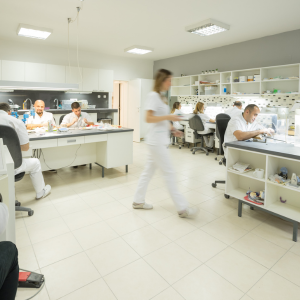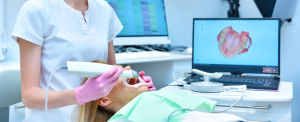Dental laboratories face a growing demand for precision and speed in the delivery of prostheses and other devices. In this context, optimizing internal processes has become essential to improve productivity, maintain competitiveness and provide quality service. From this perspective, there are strategies that must be considered to improve operational efficiency in dental laboratories, from the integration of new technologies to the improvement of human resources management.
- Automation of repetitive tasks

One of the most effective ways to optimize processes is to automate those tasks that consume time, but do not require constant manual intervention. Today, technology allows dental laboratories to automate the manufacture of dentures, such as crowns and bridges, using milling machines and CAD/CAM systems. This not only reduces the margin of error, but also frees up dental technicians to focus on more complex tasks.
- Efficient management of time and resources
Time is one of the most valuable resources in a dental laboratory. Implementing project and time management systems can help control delivery times and ensure that each project is aligned with priorities. Specific software tools for dental laboratories allow you to organize and manage the workflow, monitor the progress of each task and optimize the allocation of resources, ensuring that valuable hours are not wasted.
- Continuous training for staff
The human team remains a key piece for the success of any dental laboratory. Investing in the continuous training of technicians and other employees not only improves the quality of work, but also increases productivity. Training should include the management of new technologies, as well as the development of skills to face the daily challenges of the laboratory. A well-trained team can better adapt to market changes and work more efficiently, which translates into better results and greater production capacity.
- Optimization of CAD design through expert suppliers
One of the most important steps to improve productivity is to have an expert CAD design provider. Outsourcing the design of prostheses and other dental devices to a specialized partner not only guarantees accuracy in results, but also allows the laboratory to save time and internal resources. These companies have the ability to deliver production-ready files, specifically adapted to dental laboratory machines and materials, reducing adjustment time and ensuring smoother production. By working with CAD experts, laboratories can handle a larger volume of work and reduce the delivery time of each project.
- Integration of advanced technologies
Adopting new technologies, such as 3D printing and intraoral scanning, is another key factor in optimizing processes in a dental laboratory. These tools not only improve the accuracy of the final products, but also speed up the workflow. For example, intraoral scanners allow you to digitize prints accurately and quickly, eliminating the need for physical models and reducing printing errors. 3D printing, on the other hand, facilitates the rapid creation of models and structures, which reduces production times and improves the quality of the final product.
- Improvement in internal communication
Efficient communication between the different departments of a dental laboratory is crucial to avoid errors and optimize the workflow. Implementing digital collaboration tools can help ensure that all relevant information is available to each team member in real time. From the receipt of the order to the final delivery, everyone involved must have access to the details of the project to avoid misunderstandings and ensure that deadlines are effectively met.
- Maintenance and updating of equipment
The equipment and machines of a dental laboratory are a considerable investment. Keeping them in good condition and updating them periodically is essential to ensure that the processes are carried out efficiently. Lack of maintenance can lead to unplanned downtime, which directly affects productivity. Establishing a regular maintenance schedule for milling machines, 3D printers and other devices reduces the risk of failure and ensures that the equipment is operating at full capacity.
Optimizing processes in a dental laboratory is not only a matter of adopting new technologies, but also of better managing resources, training staff and working with the best suppliers. Investing in these areas not only improves productivity, but also allows the laboratory to offer a higher quality service, ensuring customer satisfaction and business growth.
If you are looking for ways to optimize your laboratory processes, consider how you can implement these changes to improve your operational efficiency. And if you need help implementing a more efficient CAD design process, contact us for more information on how we can support you.



